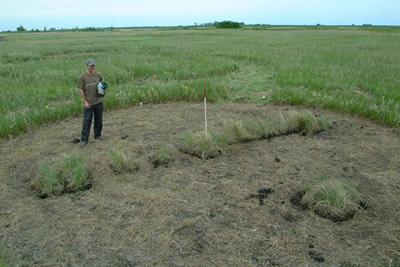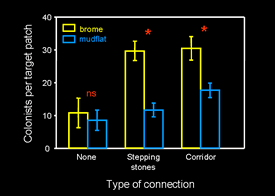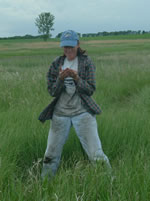Host-Parasitoid Spatial/Landscape Ecology
The Matrix Affects Connectivity of Corridors and Stepping Stones
One of the more applied aspects of our work involved assessing how matrix composition influences the efficacy of corridors and stepping stones (Baum et al. 2004). Conservation strategies often call for the utilization of corridors and/or stepping stones to promote dispersal among fragmented populations. However, the extent to which these strategies increase connectivity for an organism may depend not only on the corridors and stepping stones themselves, but also on the composition of the surrounding matrix.
To address this question, Kristen Baum (former postdoc and now an assistant professor at Oklahoma State University), several of my students, and I monitored the dispersal of marked planthoppers in experimental cordgrass patch networks embedded in a brome or mudflat matrix. Each network consisted of a central source patch surrounded by 3 vacant target patches connected to the source patch by either a corridor, 2 stepping stones, or nothing.


We found that the effectiveness of corridors and stepping stones for promoting planthopper dispersal among patches depended strongly on the intervening matrix habitat. In the low resistance matrix, brome, both stepping stones and corridors promoted high connectivity, increasing the number of colonists by 3-fold relative to patches separated by matrix habitat only. The effectiveness of stepping stones and corridors was significantly lower in the high resistance matrix, mudflat, with stepping stones failing to improve connectivity for the planthoppers relative to controls. Thus, we conclude that the matrix is an integral component of landscapes and should be considered together with corridors and stepping stones in strategies designed to increase dispersal among fragmented populations.
Presently, we do not know the underlying cause for why the corridors and stepping stones (brome matrix only) were so effective (relative to patches with only intervening matrix habitat) at increasing connectivity. One possibility is that the increase in colonists to the target patches is due solely to the movements of planthoppers through the corridors or stepping stones. Another possibility is that corridors and stepping stones are functioning as drift fences, drawing insects in from the matrix and funneling them into connected patches. Given that planthoppers are commonly found in the brome matrix (Haynes & Cronin 2003), this latter possibility is likely to be true. We are currently developing a landscape model, tailored to the spatial layout of our study system, to understand how corridors and stepping stones work to affect patch connectivity (see Cronin & Reeve 2005, Reeve et al. 2008, Reeve and Cronin 2010, Cronin and Reeve 2014).






